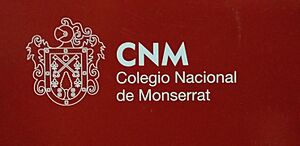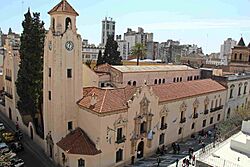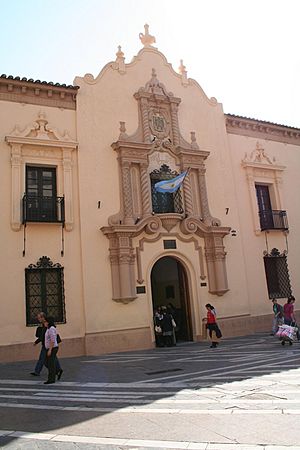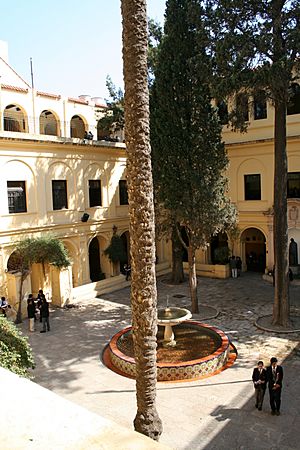Colegio Nacional de Monserrat facts for kids
Quick facts for kids Colegio Nacional de Monserrat |
|
|---|---|
 |
|
 |
|
| Address | |
|
Obispo Trejo 294
, Argentina
|
|
| Coordinates | 31°25′07″S 64°11′13″W / 31.41861°S 64.18694°W |
| Information | |
| Type | Public secondary |
| Motto | En virtud y Letras |
| Established | 1687 |
| Founder | Father Ignacio Duarte Quirós, Society of Jesus |
| Rector | Aldo Guerra |
| Gender | Coeducational |
| Enrollment | 1,589 (high school) 500 (middle school) |
| Campus | Urban |
| Athletics | Basketball, fencing, soccer |
| Mascot | Duende |
| Nickname | Monse |
| Affiliation | National University of Córdoba |
| Former names | Real Colegio Convictorio de Nuestra Señora de Monserrat · Real Universidad de San Carlos y de Nuestra Señora de Monserra |
| Notable alumni | Ramón J. Cárcano, Juan José Castelli, José Figueroa Alcorta, Gregorio Funes, Leopoldo Lugones, Dalmacio Vélez Sársfield |
The Colegio Nacional de Monserrat is a famous public high school in Córdoba, Argentina. It's one of the oldest and most respected schools in Argentina. It's like a European 'gymnasium,' which is a type of school that prepares students for university.
About the School
The Colegio Nacional de Monserrat has a high school section. Students learn many subjects, including Philosophy, Social Sciences, History, Geography, Literature, Science, Art, and Physical Education. The school also has a large library with nearly 20,000 books and a special museum about its history.
The school is managed by a group of people, including the Director, teachers, students, and parents. This group helps make important decisions for the school. There is also a separate group that manages the middle school level.
How to Get In
To join the first year of the high school, students must take and pass a special entrance exam. This exam includes tests in language and math. The school accepts the top 240 students based on their test scores.
Every year, more than 1,100 students try to get into the school. This means that less than 22% of students who take the test are accepted.
School History
Early Years
The Real Colegio Convictorio de Nuestra Señora de Monserrat (Royal Boarding School of Our Lady of Montserrat) was started in Córdoba on August 1, 1687. It was founded by a group called the Society of Jesus, also known as the Jesuits. Father Ignacio Duarte Quirós, a priest from Córdoba, founded the school and gave all his money to help it begin.
King Charles II of Spain approved the school. It officially opened as a boarding school on April 10, 1695. Later, King Philip V gave it a permanent approval on December 2, 1716.
In 1767, the school was given to the Franciscan Order. It moved to its current location, and this move was finished on February 9, 1782.
In 1807, the school became part of the Secular Clergy. This happened because King Charles IV of Spain created the "Royal University of San Carlos and Our Lady of Montserrat" in 1800. This new plan included what later became the National University of Córdoba. The school's classes were also updated by Dean Gregorio Funes, who was the head of both the University and the College.
Public School Era
In 1854, the College and the University became national institutions, meaning they were run by the government. The College changed from a boarding school to a secondary school in 1858. From 1881 onwards, it was part of the "National School" system. A new building for the school was finished in 1864.
In 1907, the school became connected to the University. In 1927, the building was updated with beautiful Spanish Colonial Revival architecture doorways and windows. This renovation was led by Rector Rafael Bonet. In 1937, a statue of the founder, Father Ignacio Duarte Quirós, was placed in the main courtyard. This was to celebrate 250 years since the school was founded.
The College of Monserrat was declared a National Historic Monument on July 14, 1938. For many years, it was a school only for boys. However, in 1997, the University decided to make it coeducational, meaning both boys and girls could attend. By 2010, there were more girls than boys enrolled in the school. In 2015, about 55% of the students were girls and 45% were boys.
The area where the school is located, known as the Jesuit Block of Córdoba, was named a World Heritage Site by UNESCO on November 28, 2000.
See also
 In Spanish: Colegio Nacional de Monserrat para niños
In Spanish: Colegio Nacional de Monserrat para niños
- List of Jesuit sites



